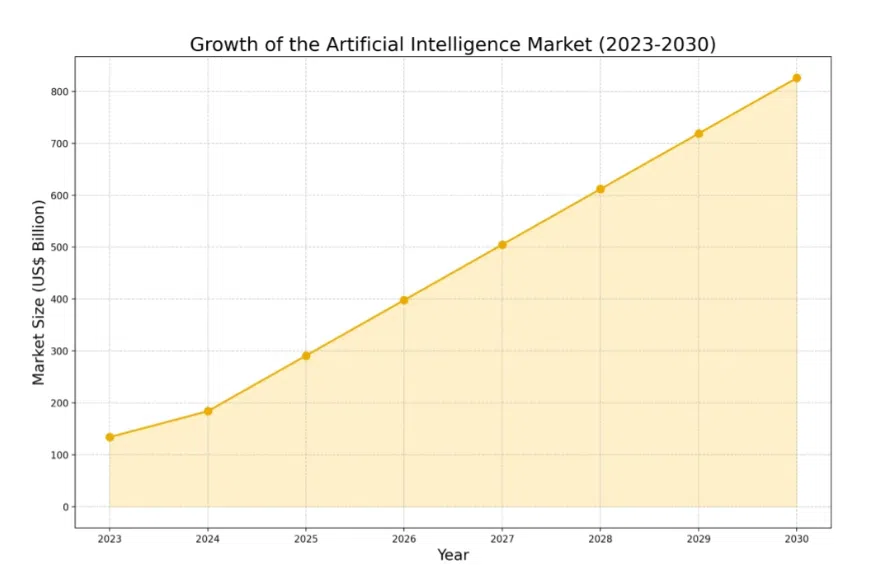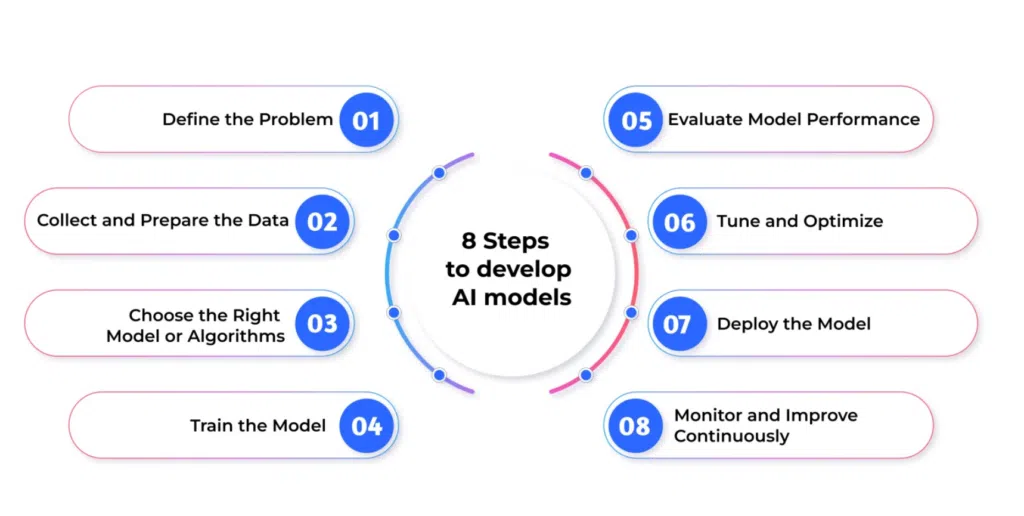AI Model Development Process: From Idea to Deployment Success
The AI model development process defines how intelligent systems are built, trained, and deployed to drive enterprise transformation. For businesses, mastering this process means leveraging data and technology to innovate faster and enhance customer experiences.
This guide breaks down each critical stage – from identifying business needs to successful deployment – to help enterprises build scalable and adaptive solutions.
1. What is an AI Model?
An AI model is a computational system designed to recognize patterns, make predictions, and automate decision-making by learning from data. It forms the foundation of modern artificial intelligence, enabling machines to simulate aspects of human reasoning and perception.
The growing importance of AI is evident in the global market’s rapid expansion. According to Statista, the market reached over $184 billion in 2024 and is projected to surpass $826 billion by 2030. This surge highlights how businesses are increasingly relying on AI-driven solutions to boost performance, optimize workflows, and enhance customer experiences.

Within this dynamic landscape, mastering the AI model development process is vital for enterprises seeking sustainable digital transformation strategy. From conceptualization to deployment, the process ensures that AI systems are accurate, scalable, and strategically aligned with business goals. As demand for intelligent solutions rises, understanding how to build and refine AI models becomes a key differentiator for success.
2. How Can Enterprises Benefit From AI Model Development?
Artificial intelligence is reshaping how enterprises operate, innovate, and compete. In this section, we explore the major areas where AI influences organizations, all closely linked to the AI model development process that drives these advancements.
2.1. Boosting Operational Efficiency and Productivity
AI empowers enterprises to automate repetitive tasks, optimize workflows, and reduce human error. By integrating insights from the AI model development process, businesses can create systems that learn continuously and improve over time. This leads to faster execution, smarter resource allocation, and better output quality. Automation tools powered by AI also help teams focus on strategic goals rather than manual work, driving productivity across departments.
In industries such as manufacturing and logistics, AI models enhance predictive maintenance and process optimization, helping companies save costs while maintaining operational excellence.
2.2. Enhancing Customer Experience and Personalization
Enterprises use AI to understand customer behavior, predict preferences, and deliver personalized interactions. Through the AI model development process, businesses can train systems on vast datasets to recommend products, customize communication, and provide real-time support. This data-driven personalization builds stronger customer relationships and increases engagement.
From chatbots to recommendation engines, AI improves response time, accuracy, and satisfaction. Organizations that invest in scalable AI infrastructures not only enhance customer loyalty but also gain a competitive advantage in a fast-evolving digital market.
2.3. Enabling Data-Driven Decision Making
The AI model development process equips enterprises with advanced analytical capabilities that transform raw data into actionable insights. Decision-makers can identify trends, forecast outcomes, and mitigate risks through AI-powered predictive models. These intelligent systems analyze millions of data points faster than traditional methods, improving accuracy and response time.
In finance, healthcare, and retail, such insights drive innovation, optimize pricing, and enhance strategic planning. By embedding AI into decision frameworks, enterprises can move from reactive to proactive management, ensuring sustainable growth and resilience in competitive environments.
Want to build an AI model for your business?
Contact Savvycom to transform your ideas into intelligent digital products powered by AI
3. AI Model Development Process: Step-by-Step
The AI model development process consists of several crucial stages, from problem definition to continuous improvement. In this section, we’ll break down the key steps involved, providing insights into each stage, and highlighting how companies can leverage these steps to develop scalable, effective AI solutions.
Step 1: Define the Problem
The foundation of the AI model development process begins with defining a clear problem statement. Enterprises must identify the specific challenges AI can address, ensuring alignment with business objectives. This stage sets measurable goals, such as improving customer service or automating manual processes, and determines what success looks like. By defining the problem accurately, businesses can focus resources effectively and avoid building models that don’t deliver tangible value.
Step 2: Collect and Prepare the Data
Data collection and preparation form the backbone of every AI model development process. High-quality, relevant data ensures that the model learns accurately. This stage includes gathering raw data, cleaning it to remove errors, and labeling it for training. Preprocessing techniques such as normalization and feature extraction help structure environmental data management effectively. Proper data preparation guarantees consistency, minimizes bias, and enhances the model’s performance during the training phase.
Step 3: Choose the Right Model or Algorithms
Selecting the appropriate model or algorithm is crucial to the AI model development process. The choice depends on factors like the problem type, data complexity, and expected outcomes. Machine learning development model, such as decision trees, neural networks, or regression algorithms, may be applied. Businesses often experiment with multiple models to compare performance metrics before final selection. The right model ensures that predictions are accurate, scalable, and suitable for real-world applications.
Step 4: Train the Model
In this stage, the model learns patterns from data. Training is the heart of the AI model development process, involving feeding large datasets into algorithms to recognize relationships and make predictions. Parameters and weights are adjusted iteratively to reduce errors. The goal is to balance model accuracy and efficiency. With high-quality data and proper tuning, training helps create a model capable of adapting to new inputs and performing well under different conditions.
Step 5: Evaluate Model Performance
After training, performance evaluation ensures that the model functions as intended. In the AI model development process, this step measures accuracy, precision, recall, and F1 scores. Evaluation helps detect underfitting or overfitting and determines whether the model generalizes well to unseen data. Businesses use test datasets to verify performance before deployment. A well-evaluated model guarantees reliability and minimizes risks when implemented in real-world scenarios.
Step 6: Tune and Optimize
Optimization fine-tunes model parameters to enhance speed and accuracy. This stage of the AI model development process involves adjusting hyperparameters, experimenting with different architectures, and minimizing computational costs. Tools like grid search or Bayesian optimization can help refine performance. The goal is to achieve a balance between accuracy and efficiency without overcomplicating the model. Continuous tuning ensures the AI solution performs optimally across various environments and data conditions.
Step 7: Deploy the Model
Once optimized, the model is ready for deployment. In the AI model development process, deployment involves integrating the model into production systems such as web or mobile applications. This allows enterprises to generate predictions in real time. Proper deployment requires robust APIs, cloud infrastructure, and security measures. Ensuring scalability during deployment enables seamless handling of large data volumes and user requests.
Step 8: Monitor and Improve Continuously
Deployment is not the end of the AI model development process. Continuous monitoring ensures that the model remains accurate and relevant as data changes over time. Businesses track metrics like prediction accuracy and data drift to identify performance declines. Retraining the model periodically with updated datasets keeps it aligned with evolving business needs. Ongoing improvement transforms AI from a one-time project into a sustainable innovation tool that continuously delivers value.
4. Common Challenges in AI Model Development
Even with a structured AI model development process, enterprises often face significant challenges that impact performance, scalability, and outcomes. Understanding these obstacles and how to address them effectively helps ensure successful AI implementation and long-term sustainability. The table below outlines key challenges, their descriptions, and practical solutions.
| Challenge | Description | Solution |
| Data Quality and Availability | Poor or insufficient data can cause inaccurate models and biased outcomes. It remains one of the biggest barriers in the AI model development process. |
Implement data validation pipelines, collect diverse datasets, and use data augmentation to improve reliability.
|
| Model Overfitting | Models may perform well on training data but fail in real-world scenarios. This reduces the practical impact of AI solutions. |
Apply regularization techniques, cross-validation, and monitor performance metrics to ensure balanced generalization.
|
| Lack of Domain Expertise | Many teams struggle to align technical capabilities with business needs, weakening the overall effectiveness of AI adoption. |
Involve domain experts early in the AI model development process to ensure models solve real business problems.
|
| Integration with Existing Systems | Deploying AI models into production systems can be complex and time-consuming for enterprises. |
Use modular APIs, cloud platforms, and DevOps pipelines to streamline integration and reduce deployment friction.
|
| Ethical and Regulatory Concerns | Misuse or biased AI models can damage trust and lead to compliance issues. |
Establish transparent governance policies, monitor for bias, and ensure compliance with data protection regulations.
|
5. Why Should Outsourcing for AI Model Development
Outsourcing has become a strategic advantage for enterprises seeking to innovate without overburdening internal resources. In this section, we’ll explore why partnering with an external team for the AI model development process helps businesses gain agility, reduce costs, and scale efficiently – while ensuring quality, compliance, and faster innovation cycles.
5.1. Access to Global Expertise and Advanced Technology
Outsourcing gives enterprises immediate access to highly skilled AI specialists and cutting-edge technologies essential for a successful AI model development process. Many companies lack in-house teams capable of handling complex data engineering, model training, or MLOps tasks. The IT outsourcing trend bridges that gap through:
- Specialized talent pools: Development vendors bring data scientists, ML engineers, and DevOps experts experienced across industries.
- Access to AI infrastructure: Partners already have high-performance computing (GPU/TPU servers) and AI frameworks ready to use.
- Continuous innovation: External teams stay up to date with AI advancements, ensuring the latest algorithms and best practices are applied.
This approach allows enterprises to scale faster and deploy AI-powered solutions with higher precision and reliability.
5.2. Cost Optimization and Faster Time-to-Market
The AI model development process often demands substantial investment in infrastructure, tools, and human resources. Outsourcing significantly reduces these costs while accelerating development timelines.
- Reduced overhead: Enterprises avoid expenses tied to hiring, training, and maintaining an internal AI team.
- Flexible pricing models: Businesses can choose project-based or hourly contracts that fit their financial capacity.
- Speed and scalability: Development partners use established workflows, allowing faster prototyping, testing, and deployment.
A comprehensive study by Deloitte shows that businesses can save up to 60% in operational costs when outsourcing AI development. This cost and time advantage enables companies to focus resources on strategic goals, while experts handle the technical demands of AI development.
5.3. Focus on Core Business Activities
By outsourcing the AI model development process, organizations can stay focused on what matters most – their core business. Instead of allocating internal teams to complex AI operations, businesses can delegate those tasks to specialists and maintain attention on strategy and growth.
- Strategic alignment: Outsourcing frees internal resources to focus on innovation, customer service, and market expansion.
- Improved productivity: Teams can leverage AI insights generated by partners without managing the underlying development.
- Enhanced business agility: With external experts handling AI systems, companies can quickly adapt to new opportunities.
5.4. Risk Reduction and Compliance Assurance
The AI model development process involves potential risks – from data security to algorithmic bias. Outsourcing partners often have established frameworks to mitigate these issues effectively.
- Data protection: Reputable vendors follow strict compliance standards like GDPR, ISO/IEC 27001, and HIPAA.
- Quality assurance: Experienced firms maintain rigorous testing to ensure accuracy, fairness, and reliability in AI outcomes.
- Regulatory compliance: Outsourcing partners understand international laws and ethical AI practices, helping businesses avoid costly legal pitfalls.
Need A Trusted Tech Partner?
At Savvycom, we combine advanced AI technologies, robust engineering skills, and domain experience to help enterprises accelerate innovation. Our development team delivers end-to-end AI solutions tailored for web and mobile app development– ensuring seamless integration, performance, and scalability.
Savvycom is right where you need. Contact us now for further consultation:
- Phone: +84 24 3202 9222
- Hotline: +1 408 663 8600 (US); +612 8006 1349 (AUS); +84 32 675 2886 (VN)
- Email: [email protected]



